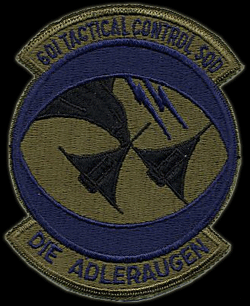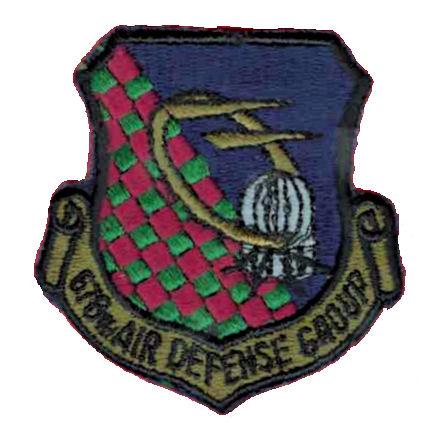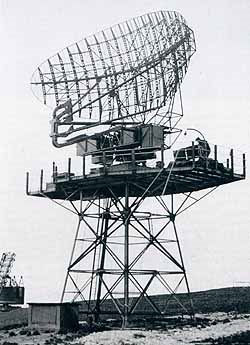|
Dauphin Island AFS
Dauphin Island Air Force Station is a closed United States Air Force General Surveillance Radar station. It is located east of Dauphin Island, Alabama, near historic Fort Gaines (Alabama). It was closed in 1980. Beginning in September 1982, the Federal Aviation Administration (FAA) acquired part of the facility. Today the site is part of the Joint Surveillance System (JSS), designated by NORAD as Eastern Air Defense Sector (EADS) Ground Equipment Facility J-12 with an ARSR-2 radar. History Dauphin Island Air Force Station came into existence as part of Phase III of the Air Defense Command Mobile Radar program. On October 20, 1953 ADC requested a third phase of twenty-five radar sites be constructed. The 693d Aircraft Control and Warning Squadron was assigned to the station on 1 September 1958. The site had an AN/FPS-20 search radar and two AN/FPS-6A height-finder radars, and initially the station functioned as an aircraft control and warning station. The Ground Air T ... [...More Info...] [...Related Items...] OR: [Wikipedia] [Google] [Baidu] |
Air Defense Command
Aerospace Defense Command was a major command (military formation), command of the United States Air Force, responsible for continental air defense. It was activated in 1968 and disbanded in 1980. Its predecessor, Air Defense Command, was established in 1946, briefly inactivated in 1950, reactivated in 1951, and then redesignated ''Aerospace'' rather than ''Air'' in 1968. Its mission was to provide air defense of the Continental United States (CONUS). It directly controlled all active measures, and was tasked to coordinate all passive means of air defense. Air defense during World War II Continental United States air defense forces during World War II were initially under the command of the four air districts – Northeast Air District, Northwest Air District, Southeast Air District, and Southwest Air District. The air districts were established on 16 January 1941, before the Pearl Harbor attack. The four air districts also handled USAAF combat training with the Army Ground F ... [...More Info...] [...Related Items...] OR: [Wikipedia] [Google] [Baidu] |
693d Radar Squadron
The 693d Radar Squadron is an inactive United States Air Force unit. It was last assigned to the 20th Air Division, Aerospace Defense Command, stationed at Dauphin Island Air Force Station, Alabama. It was inactivated on 30 September 1970. The unit was a General Surveillance Radar squadron providing for the air defense of the United States. Lineage * Established as 693d Aircraft Control and Warning Squadron : Activated on 1 April 1958 : Redesignated as 693d Radar Squadron (SAGE) on 1 March 1961 : Inactivated on 30 September 1970 Assignments * 35th Air Division, 1 April 1958 * 32d Air Division, 15 November 1958 * Montgomery Air Defense Sector, 1 November 1959 * 32d Air Division, 1 April 1966 * 33d Air Division, 14 November 1969 * 20th Air Division, 19 November 1969 – 30 September 1970 Stations * Dobbins AFB Dobbins Air Reserve Base or Dobbins ARB is a United States Air Force reserve air base located in Marietta, Georgia, a suburb about northwest of Atlanta. Originally ... [...More Info...] [...Related Items...] OR: [Wikipedia] [Google] [Baidu] |
Radar Stations Of The United States Air Force
Radar is a detection system that uses radio waves to determine the distance (''ranging''), angle, and radial velocity of objects relative to the site. It can be used to detect aircraft, ships, spacecraft, guided missiles, motor vehicles, weather formations, and terrain. A radar system consists of a transmitter producing electromagnetic waves in the radio or microwaves domain, a transmitting antenna, a receiving antenna (often the same antenna is used for transmitting and receiving) and a receiver and processor to determine properties of the objects. Radio waves (pulsed or continuous) from the transmitter reflect off the objects and return to the receiver, giving information about the objects' locations and speeds. Radar was developed secretly for military use by several countries in the period before and during World War II. A key development was the cavity magnetron in the United Kingdom, which allowed the creation of relatively small systems with sub-meter resolution. The ... [...More Info...] [...Related Items...] OR: [Wikipedia] [Google] [Baidu] |
Installations Of The United States Air Force In Alabama ) or political one
{{disambig ...
Installation may refer to: * Installation (computer programs) * Installation, work of installation art * Installation, military base * Installation, into an office, especially a religious (Installation (Christianity) Installation is a Christian liturgical act that formally inducts an incumbent into a new role at a particular place such as a cathedral. The term arises from the act of symbolically leading the incumbent to their stall or throne within the cathedra ... [...More Info...] [...Related Items...] OR: [Wikipedia] [Google] [Baidu] |
List Of United States Air Force Aircraft Control And Warning Squadrons
This Article is a list of United States Air Force aircraft control and warning squadrons active, inactive, and historical. The purpose of a ''aircraft control and warning squadron'' is to provide an airborne radar picket to detect vessels, planes, and vehicles before they enter an area of operations, as well as providing command and control in an engagement by directing aircraft strikes. Additionally they may be used to carry out surveillance, including over ground targets. Site codes Sites within the United States * DC-xx Semi-Automatic Ground Environment (SAGE) Direction Center/Combat Center. * F-xx Alaskan air defense sites. * H-0x Hawaiian air defense sites. * L-xx Original Air Defense Command (ADC) 1946 "Lashup" Radar Network of temporary sites to provide detection at designated important locations using radar sets left over from World War II. * LP-xx "Lashup" site which was incorporated into the first ADC permanent radar network in 1949. * P-xx Original 75 permanent station ... [...More Info...] [...Related Items...] OR: [Wikipedia] [Google] [Baidu] |
List Of USAF Aerospace Defense Command General Surveillance Radar Stations
United States general surveillance radar stations include Army and USAF stations of various US air defense networks (in reverse chronological order): *Joint Surveillance System (JSS), with radar stations controlled by joint FAA/USAF ROCCs beginning in 1980 *SAGE radar stations, for the Semi-Automatic Ground Environment network prior to the JSS (the 1st SAGE squadrons were designated in 1958) *Alaska Ring radar net, the radar stations of Alaskan Air Command *Permanent System radar stations, the Air Defense Command manual network of radar stations prior to deployment of SAGE *Lashup Radar Network radar stations, the radar stations deployed 1950-2 when the "Radar Fence" Plan was not approved * Temporary radar net, the "five-station radar net" established in 1948 *Army Radar Stations, World War II installations of the Aircraft Warning Service with radars (cf. filter centers, Ground Observer Corps stations, etc.) By usage: *RBS Express sites, temporary stations for Radar Bomb Scoring t ... [...More Info...] [...Related Items...] OR: [Wikipedia] [Google] [Baidu] |
United States Coast Guard
The United States Coast Guard (USCG) is the maritime security, search and rescue, and law enforcement service branch of the United States Armed Forces and one of the country's eight uniformed services. The service is a maritime, military, multi-mission service unique among the United States military branches for having a maritime law enforcement mission with jurisdiction in both domestic and international waters and a federal regulatory agency mission as part of its duties. It is the largest and most powerful coast guard in the world, rivaling the capabilities and size of most navies. The U.S. Coast Guard is a humanitarian and security service. It protects the United States' borders and economic and security interests abroad; and defends its sovereignty by safeguarding sea lines of communication and commerce across vast territorial waters spanning 95,000 miles of coastline and its Exclusive Economic Zone. With national and economic security depending upon open global trade a ... [...More Info...] [...Related Items...] OR: [Wikipedia] [Google] [Baidu] |
Dauphin Island Sea Lab
The Dauphin Island Sea Lab (DISL) is Alabama's primary marine education and research center. DISL is the home site of the Marine Environmental Sciences Consortium and was founded by an act of the Alabama State Legislature in 1971. It also has a public aquarium specializing in estuarine organisms, the George F. Crozier Estuarium. The facilities are located on the East end of Dauphin Island, and occupy grounds formerly owned by the US Air Force for the 693rd Radar Squadron. It is located across the street from historic Fort Gaines. Estuarium The George F. Crozier Estuarium is part of the Discovery Hall educational program at the Dauphin Island Sea Lab. It includes a 10,000 square foot Exhibit Hall and a Living Marsh Boardwalk. The Exhibit Hall features four exhibits highlighting aquatic life that could be found in the Mobile-Tensaw River Delta, Mobile Bay, the Barrier Islands and the Northern Gulf of Mexico. * The Mobile-Tensaw River Delta exhibit recreates Alabama's largest we ... [...More Info...] [...Related Items...] OR: [Wikipedia] [Google] [Baidu] |
678th Air Defense Group
The 678th Air Defense Group is a disbanded United States Air Force organization. Its last assignment was with the 20th Air Division of Air Defense Command (ADC) at Tyndall Air Force Base, Florida. The group was formed in 1970 when ADC expanded its radar units that operated Back-Up Interceptor Control sites from squadron sized units to groups. From 1977 until it was inactivated in 1983 the 678th was responsible for operating the Southern Air Defense System. History The 678th Air Defense Group replaced the 678th Radar Squadron (SAGE) (formerly the 678th Aircraft Warning & Control Squadron) at Tyndall Air Force Base in 1970.Cornett & Johnson, p. 85 The group operated a Back-Up Interceptor Control (BUIC) site with the mission to back up the centralized and vulnerable Semi-Automatic Ground Environment (SAGE) operations center of the 20th Air Division at Gunter Air Force Base, Alabama. The BUIC III operated by the group gave the unit a semi-automatic control capability, unlike ear ... [...More Info...] [...Related Items...] OR: [Wikipedia] [Google] [Baidu] |
630th Radar Squadron '', 2016
{{Numberdis ...
63 may refer to: * 63 (number) * one of the years 63 BC, AD 63, 1963, 2063 * +63, telephone country code in the Philippines * Flight 63 (other) * ''63'' (album), by Tree63 * ''63'' (mixtape), by Kool A.D. * "Sixty Three", a song by Karma to Burn from the album ''Mountain Czar ''Mountain Czar'' is an EP by the instrumental stoner rock band Karma to Burn. It was released in 2016 by SPV and Rodeostar Records. Unlike their previous release '' Arch Stanton'', ''Mountain Czar'' is not exclusively instrumental, with one ... [...More Info...] [...Related Items...] OR: [Wikipedia] [Google] [Baidu] |
AN/FPS-93
The AN/FPS-20 was a widely used L band early warning and ground-controlled interception radar system employed by the United States Air Force Air Defense Command, the NORAD Pinetree Line in Canada, the USAF CONAD in the continental United States, and a variety of other users. The design started life as the Bendix AN/FPS-3 in 1950, was upgraded to the FPS-20, then spawned over a dozen different variants as additional upgrades were applied. The FPS-20 formed the backbone of the US air defense network through the early Cold War with over 200 units deployed. Most FPS-20 sites were replaced by modern equipment in the late 1960s, although a number were turned over to the FAA, modified for air traffic control use, and became ARSR-60s. The first AN/FPS-3 arrived in December 1950, slated for installation at Eniwetok Atoll to control aircraft involved in the atomic bomb tests of early 1951. Over the next few years, 48 FPS-3s were installed to replace older systems in the Lashup Radar Netw ... [...More Info...] [...Related Items...] OR: [Wikipedia] [Google] [Baidu] |
Fort Lawton
Fort Lawton was a United States Army post located in the Magnolia neighborhood of Seattle, Washington overlooking Puget Sound. In 1973 a large majority of the property, 534 acres of Fort Lawton, was given to the city of Seattle and dedicated as Discovery Park. Both the fort and the nearby residential neighborhood of Lawton Wood are named after Major General Henry Ware Lawton. While Fort Lawton was a quiet outpost prior to World War II, it became the second largest port of embarkation of soldiers and materiel to the Pacific Theater during the war. The fort was included in the 2005 Base Realignment and Closure list. Fort Lawton officially closed on September 14, 2011. History In 1896, the Secretary of War selected what would later be Fort Lawton for construction of an artillery battery intended to defend Seattle and the south Puget Sound from naval attack. Local citizens and governments donated land to the United States Army for the installation the next year. Fort Lawton w ... [...More Info...] [...Related Items...] OR: [Wikipedia] [Google] [Baidu] |




